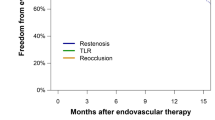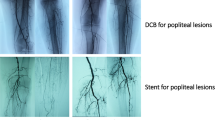Abstract
The demand for endovascular therapy is increasing in an aging society, but the problem of restenosis in the chronic phase has not been resolved in femoropopliteal occlusive disease. Few studies have compared drug-coated balloon (DCB) and scaffold devices in chronic total occlusion (CTO) of the superficial femoral artery (SFA). This study aimed to compare DCBs with scaffold in patients with CTO of the SFA. This was a single-center, retrospective study. From June 2018 to December 2019, we compared 31 patients and 33 limbs treated with DCBs and 44 patients and 45 limbs treated with a stent or stent-graft (scaffold) for SFA CTO. The primary endpoint was 12-month primary patency. The secondary endpoints were 12-month freedom from clinically driven target lesion revascularization (CD-TLR) and 12-month freedom from re-occlusion. The DCBs were performed using an intravascular ultrasound (IVUS)-guided approach or a non-loop wire technique. Baseline characteristics were similar between the groups. An intraluminal approach was performed to use all DCBs. The bailout stent rate was 0% in the DCB group. Kaplan–Meier analysis showed that rates of 12-month primary patency tended to be higher in the DCB than in the scaffold group (92.7 vs. 76.6%, p = 0.073) and that freedom from CD-TLR also did not differ significantly between the two groups (96.8 vs. 86.3%, p = 0.17). Kaplan–Meier analysis also showed that the 12-month freedom from re-occlusion rate was significantly less in the Scaffold than in the DCB group (96.8 vs. 79.3%, p = 0.045). Therefore, we concluded that in treatment for CTO of the SFA, a DCB with intraluminal angioplasty without bailout stenting was less re-occlusion compared with scaffold.



Similar content being viewed by others
References
Norgen L, Hiatt WR, Dormandy JA, Nehler MR, Harris KA, Fowkes FGR, TASC II Working Group (2007) Inter-society consensus for the management of peripheral arterial disease (TASC II). J Vasc Surg 45(Suppl S):S5–S67
Soga Y, Iida O, Hirano K, Yokoi H, Nanto S, Nobuyoshi M (2010) Mid-term clinical outcome and predictors of vessel patency after femoropopliteal stenting with self-expandable nitinol stent. J Vasc Surg 52:608–615
Soga Y, Takahara M, Iida O, Suzuki K, Hirano K, Kawasaki D, Shintani Y, Yamaoka T, Ando K (2015) Relationship between primary patency and lesion length following bare nitinol stent placement for femoropopliteal disease. J Endovasc Ther 22:862–867
Iida O, Soga Y, Urasawa K, Saito S, Jaff MR, Wang H, Ookubo H, Yokoi H, MDT-2113 SFA Japan Investigators (2018) Drug-coated balloon vs standard percutaneous transluminal angioplasty for the treatment of atherosclerotic lesions in the superficial femoral and proximal popliteal arteries: one-year results of the MDT-2113 SFA Japan Randomized Trial. J Endovasc Ther 25:109–117
Kawasaki D, Tsujino T, Fujii K, Masutani M, Ohyanagi M, Masuyama T (2008) Novel use of ultrasound guidance for recanalization of iliac, femoral, and popliteal arteries. Catheter Cardiovasc Interv 71:727–733
Kitrou P, Parthipun A, Diamantopoulos A, Paraskevopoulos I, Karunanithy N, Katsanos K (2015) Targeted true lumen re-entry with the Outback catheter: accuracy, success, and complications in 100 peripheral chronic total occlusions and systematic review of the literature. J Endovasc Ther 22:538–545
Urasawa K, Sato K, Koshida R, Honma Y (2014) Trans-collateral angioplasty for the treatment of long chronic total occlusions of superficial femoral arteries: a novel wiring technique. J Cardiovasc Surg (Torino) 55:395–400
Tan M, Urasawa K, Koshida R, Haraguchi T, Kitani S, Igarashi Y, Sato K (2017) Anterolateral popliteal puncture technique: a novel retrograde approach for chronic femoropopliteal occlusions. J Endovasc Ther 24:525–530
Hayakawa N, Kodera S, Sakkya S, Ohki N, Kanda J (2021) Efficacy and safety of angiography-guided retrograde posterior popliteal puncture technique in the supine position. Ann Vasc Surg 71:264–272
Scheinert D, Micari A, Brodmann M, Tape G, Peeters P, Jaff MR, Wang H, Schmahl R, Zeller T, IN.PACT Global Study Investigators (2018) Drug-coated balloon treatment for femoropopliteal artery disease. Circ Cardiovasc Interv 11:e005654
Tepe G, Micari A, Keirse K, Zeller T, Scheinert D, Li P, Schmahl R, Jaff MR, IN.PACT Global Study Investigators (2019) Drug-coated balloon treatment for femoropopliteal artery disease: the chronic total occlusion cohort in the IN.PACT global study. JACC Cardiovasc Interv 12:484–493
Zeller T, Rastan A, Macharzina R, Tape G, Kaspar M, Chavarria J, Beschorner U, Schwarzwälder U, Schwarz T, Noory E (2014) Drug coated balloons vs. drug-eluting stents for treatment of long femoropopliteal lesions. J Endovasc Ther 21:359–368
AbuRahma AF, AbuRahma ZT, Scott G, Adams E, Beasley M, Davis M, Dean LS, Davis E (2019) Clinical outcome of drug-coated balloon angioplasty in patients with femoropopliteal disease: a real-world single-center experience. J Vasc Surg 70:1950–1959
Ohki T, Kichikawa K, Yokoi H, Uematsu M, Yamaoka T, Maeda K, Kanaoka Y (2017) Outcomes of the Japanese multicenter Viabahn trial of endovascular stent grafting for superficial femoral artery lesions. J Vasc Surg 66:130–142
Bausback Y, Wittig T, Schmidt A, Zeller T, Bosiers M, Peeters P, Brucks S, Lottes AE, Scheinert D, Steiner S (2019) Drug-eluting stent versus drug-coated balloon revascularization in patients with femoropopliteal arterial disease. J Am Coll Cardiol 73:667–679
Tosaka A, Soga Y, Iida O, Ishihara T, Hirano K, Suzuki K, Yokoi H, Nanto S, Nobuyoshi M (2012) Classification and clinical impact of restenosis after femoropopliteal stenting. J Am Coll Cardiol 59:16–23
Liistro F, Angioli P, Porto I, Ducci K, Falsini G, Ventoruzzo G, Ricci L, Scatena A, Grotti S, Bolognese L (2019) Drug-eluting balloon versus drug-eluting stent for complex femoropopliteal arterial lesions: The DRASTICO study. J Am Coll Cardiol 74:205–215
Kawasaki D, Iida O, Fukunaga M, Kato M, Ohkubo N (2015) Wire passage of 0.035-inch looped wire technique for femoropopliteal long total occlusions. J Atheroscler Thromb 22:1071–1079
Fujihara M, Takahara M, Sasaki S, Nanto K, Utsunomiya M, Iida O, Yokoi Y (2017) Angiographic dissection patterns and patency outcomes after balloon angioplasty for superficial femoral artery disease. J Endovasc Ther 24:367–375
Rocha-Singh KJ, Zeller T, Jaff MR (2014) Peripheral arterial calcification: prevalence, mechanism, detection, and clinical implications. Catheter Cardiovasc Interv 83:E212-220
Iida O, Soga Y, Urasawa K, Saito S, Jaff MR, Wang H, Ookubo H, Yokoi H, MDT-2113 SFA Japan Investigators (2019) Drug-coated balloon versus uncoated percutaneous transluminal angioplasty for the treatment of atherosclerotic lesions in the superficial femoral and proximal popliteal artery: 2-year results of the MDT-2113 SFA Japan randomized trial. Cathetr Cardiovasc Interv 93:664-672
Tsubakimoto Y, Isodono K, Fujimoto T, Kirii Y, Shiraga A, Kasahara T, Ariyoshi M, Irie D, Sakatani T, Matsuo A, Inoue K, Fujita H (2021) IVUS-guided wiring improves the clinical outcomes of angioplasty for long femoropopliteal CTO compared with the conventional intraluminal approach. J Atheroscler Thromb 28:365–374
Shimada T, Shima Y, Miura K, Shimizu H, Takamatsu M, Ikuta A, Habara S, Tanaka H, Goto T, Kadota K (2021) Impact of guidewire route on severe dissection after balloon angioplasty for femoropopliteal chronic total occlusion lesions: an intravascular ultrasound analysis. Eur J Vasc Endovasc Surg. https://doi.org/10.1016/j.ejvs.2021.01.014
Horie K, Tanaka A, Taguri M, Kato S, Inoue N (2018) Impact of prolonged inflation times during plain balloon angioplasty on angiographic dissection in femoropopliteal lesions. J Endovasc Ther 25:683–691
Tan M, Urasawa K, Koshida R, Haraguchi T, Kitani S, Igarashi Y, Sato K (2018) Comparison of angiographic dissection patterns caused by long vs short balloons during balloon angioplasty of chronic femoropopliteal occlusions. J Endovasc Ther 25:192–200
Soga Y, Fujihara M, Tomoi Y, Iida O, Ishihara T, Kawasaki D, Ando K (2020) One-year late lumen loss between a polymer-coated paclitaxel eluting stent (Eluvia) and a polymer-free paclitaxel-coated stent (Zilver PTX) for femoropopliteal disease. J Atheroscler Thromb 27:164–171
Banerjee S, Sarode K, Mohammad A, Gigliotti O, Baig MS, Tsai S, Shammas NW, Prasad A, Abu-Fadel M, Klein A, Armstrong EJ, Jeon-Slaughter H, Brilakis ES, Bhatt DL (2016) Femoropopliteal artery stent thrombosis: report from the excellence in peripheral artery disease registry. Circ Cardiovasc Interv 9:e002730
Fanelli F, Cannavale A, Gazzetti M, Lucatelli P, Wlderk A, d’Adamo A, Salvatori FM (2014) Calcium burden assessment and impact on drug-eluting balloons in peripheral arterial disease. Cardiovasc Intervent Radiol 37:898–907
Acknowledgements
We thank Ellen Knapp, PhD, from Edanz Group (https://jp.edanz.com/ac), for editing a draft of this manuscript.
Funding
This research received no specific grants from any funding agency in the public, commercial, or not-for-profit sectors.
Author information
Authors and Affiliations
Corresponding author
Ethics declarations
Conflict of interest
The authors declare no potential conflicts of interest regarding the research, authorship, and/or publication of this article.
Ethical approval
All procedures were performed in accordance with the ethical standards of the institutional and/or national research committee and with the 1964 Declaration of Helsinki and its later amendments or comparable ethical standards. The study was approved by the Institutional Review Board (IRB) of Asahi General Hospital.
Additional information
Publisher's Note
Springer Nature remains neutral with regard to jurisdictional claims in published maps and institutional affiliations.
Rights and permissions
About this article
Cite this article
Hayakawa, N., Kodera, S., Arakawa, M. et al. Clinical outcome of drug-coated balloon versus scaffold device in patients with superficial femoral artery chronic total occlusion. Heart Vessels 37, 282–290 (2022). https://doi.org/10.1007/s00380-021-01912-0
Received:
Accepted:
Published:
Issue Date:
DOI: https://doi.org/10.1007/s00380-021-01912-0




